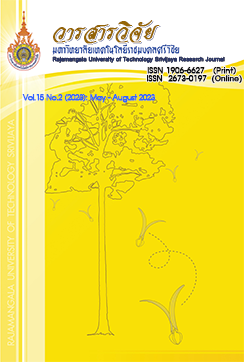Inhibitory Effect of Microalgae Crude Extracts on Antifungal in Fruit Rot Disease of Rambutan
Keywords:
microalgae, crude extract, inhibition of rambutan fruit rot disease causesAbstract
Rambutan (Nephelium lappaceum Linn.) is a tropical fruit in Thailand that has economic value in the market, however the fruit rot disease caused by various fungal pathogens such as Aspergillus sp., Colletotrichum sp., Phomopsis sp., and Pestalotiopsis sp. affects both quality and shelf life. Many farmers used chemicals such as copper oxychloride and sulfur to control the disease, but the use of chemicals affects health and environment as well as increases costs. This research aimed to screen the microalgae in the soil collected from Nam Rad Forest Headwaters, Khiri Rat Nikhom District, Surat Thani, and to test the antifungal activity from the crude extracts against fruit rot disease. The screening results showed 8 species of microalgae, including Haematococcus sp., Fischerella sp, Oscillatoria sp., Hapalosiphon sp., Calothrix sp., Anabaena sp., Aphanocapsa sp. and Scytonema sp. and 4 isolates of fungi cause the fruit rot disease in rambutan, including Penicillium sp., Corticium sp., Pestalotiopsis sp., and Lasiodiplodia sp. Microalgae extracted by methanol yielded 4.45 - 5.37 percent, while the ethyl acetate-extracted yielded 4.48 - 5.39 percent. The evaluation of antifungal activity using disc diffusion technique revealed that the extraction from 3 genera of microalgae cultured in BG-11 medium for 12 days, including Oscilatoria sp., Fischerella sp., and Anabaena sp., could inhibit the rambutan fruit rot disease fungi. Oscillatoria sp. extracted with methanol had the most effective inhibition activity against the rambutan fruit rot disease caused by Lasiodiplopia spp. followed by Oscillatoria sp. extracted with ethyl acetate, with a mean inhibition zone of 15.25 and 14.5 mm, respectively. Anabaena sp. extracted with ethyl acetate inhibited the growth of Corticium sp., while Fischerella sp. extracted with methanol inhibited the growth of Lasiodiplopia spp. with a mean inhibition zone of 11.05 mm.
References
Abdel-Monaim, M.F., Mazen, M.M. and Atwa, M.A.A.M. 2016. Effect of cyanobacteria on reducing damping-off and root rot incidence in lupine plants, New Valley Governorate, Egypt. British Microbiology Research Journal 16(2): 1-14.
Alwathnani, H.A. and Perveen, K. 2012. Biological control of Fusarium wilt of tomato by antagonist fungi and cyanobacteria. African Journal of Biotechnology 11(5): 1100-1105.
Belete, T. and Boyraz, N. 2019. Biotechnological tools for detection, identification and management of plant diseases. African Journal of Biotechnology 18(29): 797-807.
Chirawut, B. 2014. Fruit rot disease of harvested rambutan and its control. Thai Agricultural Research Journal 32(1): 89-109. (in Thai)
Choi, Y.W., Hyde, K.D. and Ho, W.H. 1999. Single spore isolation of fungi. Fungal Diversity 3: 29-38.
De Morais, M.G., Vaz, B.D.S., De Morais, E.G. and Costa, J.A.V. 2015. Biologically active metabolites synthesized by microalgae. BioMed Research International (Suppl. 1): 1-15.
Goncalves, A.L. 2021. The use of microalgae and cyanobacteria in the improvement of agricultural practices: A review on their biofertilising, biostimulating and biopesticide roles. Applied Sciences 11(871): 1-21.
Gonzalez del Val, A., Platas, G., Basilio, A., Cabello, A., Gorrochategui, J., Suay, I., Vicente, F., Protillo, E., Jimenez del Rio, M., Reina, G.G. and Pelaez, F. 2001. Screening of antimicrobial activities in red, green and brown macroalgae from Gran Canaria (Canary Islands, Spain). International Microbiology 4(1): 35-40.
Grodowska, K. and Parczewski, A. 2010. Organic solvents in the pharmaceutical industry. Acta Poloniae Pharmaceutica-Drug Research 67: 3-12.
Guerreiro, A., Andrade, M.A., Menezes, C., Vilarinho, F. and Dias, E. 2020. Antioxidant and cytoprotective properties of cyanobacteria: Potential for biotechnological applications. Toxins 12(548): 1-18.
Haggag, W., Abd El-Aty, A.M. and Mohamed, A.A. 2014. The potential effect of two cyanobacteria species; Anabaena sphaerica and Oscillatoria agardhii against storage fungi. European Scientific Journal 10(30): 1857-7881.
Kim, J. and Kim, J.D. 2008. Inhibitory effect of algal extracts on mycelial growth of the tomato-wilt pathogen, Fusarium oxysporum f. sp. Lycopersici. Mycobiology 36(4): 242-248.
Nandagopal, P., Steven, A.N., Chan, L.N., Rahmat, Z., Jamaluddin, H. and Noh, N.I.M. 2021. Bioactive metabolites produced by cyanobacteria for growth adaption and their pharmacological properties. Biology 10: 1-24.
Nicolopoulou-Stamati, P., Maipas, S., Kotampasi, C., Stamatis, P. and Hens, L. 2016. Chemical pesticides and human health: The urgent need for a new concept in agriculture. Frontiers in Public Health 4: 148.
Righini, H., Francioso, O., Quintana, A.M. and Roberti, R. 2022. Cyanobacteria: A natural source for controlling agricultural plant diseased caused by fungi and oomycetes and improving plant growth. Horticultural 8(1): 58.
Sanosomneng, K., Bussabong, N., Sangchotea, S. and Tongsri, V. 2019. Fungal pathogens of rambutan (Nephelium lappaceum L.) fruit rot and disease control using salicylic acid. Thai Science and Technology Journal 28(7): 1216-1226. (in Thai)
Shishido, T.K., Humisto, A., Jokela, J., Liu, L., Wahlsten, M., Tamrakar, A., Fewer, D.P., Permi, P., Andreote, A.P.D., Fiore, M.F. and Sivonen, K. 2015. Antifungal compounds from cyanobacteria. Marine Drugs 13(4): 2124-2140.
Singh, N.K., Dhar, W.D. and Tabassum, R. 2016. Role of cyanobacteria in crop protection, pp. 1-8. In The Proceedings of the National Academy of Sciences. India.
Thimabut, K., Srisawat, T. and Ummarat, N. 2016. Efficiency of khium (Cotylelobium lanceolatum Craib.) branch extracts against pathogenic fungi causing postharvest disease of rambutan fruit. Songklanakarin Journal of Plant Science 3(Suppl. I): 132-137. (in Thai)
Tiwari, A. and Kaur., A. 2014. Allelopathic impact of cyanobacteria on pathogenic fungi. International Journal of Pour & Applied Bioscience 2(3): 63-70.
Utaida, S., Khlangmake, V., Chittapun, S. and Charoenrat, T. 2014. Screening of antibacterial substances from cyanobacteria Anabaena spp. and Nostoc spp. Thai Journal of Science and Technology 22(2): 147-157. (in Thai)
Wehr, J.D. and Sheath, R.G. 2003. Freshwater Algae of North America Ecology and Classification. 1st ed. Academic Press, Boston.
Downloads
Published
How to Cite
Issue
Section
License
Copyright (c) 2023 Rajamangala University of Technology Srivijaya Research Journal

This work is licensed under a Creative Commons Attribution-NonCommercial-NoDerivatives 4.0 International License.
The content and information in the article published in Journal of Rajamangala University of Technology Srivijaya It is the opinion and responsibility of the author of the article. The editorial journals do not need to agree. Or share any responsibility.







